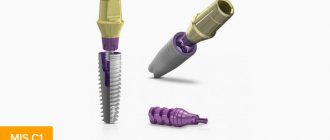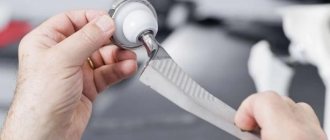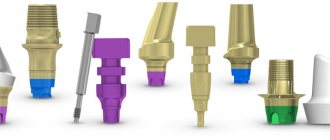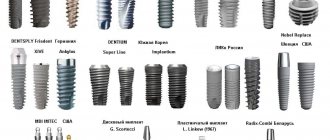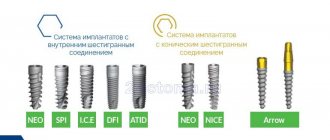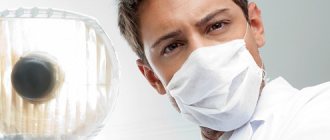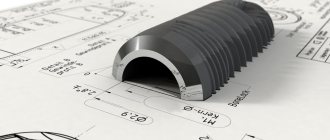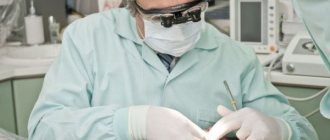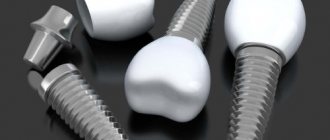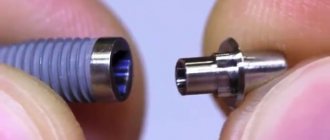Note! ARTE-S dentistry is very careful in the selection of materials. This is preceded by diagnostic studies, which reduces abnormal phenomena and complications to zero. We have modern equipment and advanced tools, high-quality materials and qualified specialists.
The good news is that intolerance manifests itself in 4-6% of people. A person may not tolerate titanium and nickel, zinc and vanadium, copper and tin, steel and gold, chrome and silver, platinum and other materials from which orthodontic systems are made. The most difficult ones are cobalt-chromium alloy, stainless steel and nickel. They are difficult to take root and difficult to work and care for. Therefore, in our center we rarely recommend them, except when necessary. With them, patients may experience a burning sensation in the mouth and a sour taste, including loss of taste.
It is a completely different matter if the patient decides to install a system made of platinum, silver or gold, that is, from noble metals. True, they are not very popular, since the cost of precious metals in modern dentistry is very high, which means they are available only to wealthy clients. And yet, such models are extremely rarely rejected by the body; their risk of rejection is minimal.
Allergies to titanium implants are very rare. It is a metal that is biologically inert. Less than 2-3% of people complained of hypersensitivity. What could this be connected with? It must be remembered that absolute purity of titanium can be achieved, but this procedure will be labor-intensive and expensive. In addition, this process is unproductive. Therefore, any titanium alloys contain a small proportion of impurities. The quantity depends on the smelting process itself, the technology for obtaining the metal, and the price of the structure.
The negative reaction that occurs after surgery is most often a consequence of corrosion of added impurities or oxidation. True, sometimes in some patients even tests show a reaction into intolerance to this material, although the percentage of such clients is very tiny.
WITH 99% ACCURACY!
“Bionic Dentis” is the only dental clinic in Moscow where you can undergo an analysis of the survival rate of dental implants (Titanium intolerance TEST). Our European partner guarantees diagnostics for implant rejection at the highest level.
______________________________________________________________________
Our clinic is the exclusive representative of the German laboratory IMD Institut für Medizinische Diagnostik Berlin-Potsdam GbR in the Russian Federation and CIS countries, which works with a unique technique for determining intolerance to titanium implants (Titanium intolerance TEST).
The laboratory is accredited by DAKKS Certificate D-ML-13142-01-00, as well as Certificate D-PL-13142-01-00, which guarantees the highest level of molecular diagnostics according to European standards.
We will help you determine in advance whether your implants will take root or not, which will help you avoid such a painful complication as implant rejection and spend money wisely on dental services without the risk of losing them.
_____________________________________________________________________
IMPORTANT!
If you are planning to install dental implants, you need to find out in advance whether they will take root with you.
______________________________________________________________________
The installation of dental implants is associated with large financial costs for the patient, which is why it is necessary to know in advance that allergies to implants will not occur.
According to European statistics, 26% of the population has a genetic intolerance to titanium , from which dental implants are made.
Requirements for prostheses to replace those that cause allergies
Metal-ceramic prostheses can be replaced with structures made of zirconium oxide. Zirconium does not cause allergies and does not oxidize in the oral cavity under the influence of saliva and other liquids.
Products made of gold, platinum, titanium, and precious metals are safe in this regard. But they are expensive, not everyone can afford them.
If you are allergic to an acrylic prosthesis, you should use acryfree, that is, a material that does not contain acrylic plastic. Or new generation products, with a minimum amount of substances that can cause a reaction, nylon prostheses.
Let us repeat, you can select dental material for a new prosthesis only after a complete examination by an allergist.
The main requirement for a prosthesis is not only strength and aesthetics, but also resistance to chemical attack. Do not oxidize when interacting with saliva and food, be hypoallergenic and safe for the body as a whole.
Get laboratory diagnostics for titanium intolerance in Germany:
- if you want to insure yourself against implant rejection
- if you want to know that you are not paying for implantation in vain
- if you want to correctly and individually select the material for dental implants
Implantologists at German and Swiss VIP implantology clinics recommend diagnosing titanium tolerance in 100% of patients, thereby insuring themselves and their patients from severe complications after the installation of dental implants and rejection of dental implants.
_______________________________________________________________________
IMPORTANT!
IN THE RF AND CIS COUNTRIES, TESTS FOR TITANIUM INTOLERANCE AND REJECTION OF TITANIUM IMPLANTS ARE NOT CONDUCTED!
_______________________________________________________________________
There are 2 types of studies that predict implant failure:
1. Type of determination of intolerance to titanium implants (Titanium intolerance TEST)
This study is recommended for all patients before installing even 1 dental implant.
The cost of Titanium intolerance TEST is 19,800 rubles 00 kopecks.
The analysis is carried out directly in a laboratory in Germany.
The price includes blood collection and transportation of blood samples to Germany.
1. The type of study includes determination of intolerance to titanium implants (Titanium intolerance TEST) and determination of genetic polymorphism of interleukins (Degree of inflammation IL-1, IL-1RN, TNF-alpha-genotype).
This study is recommended for patients to undergo before installing 4 or more dental implants and especially when installing zygomatic implants. This test, with a positive conclusion, indicates not only the possibility of early implant rejection, but also indicates late implant rejection.
Cost Titanium intolerance TEST + Degree of inflammation TEST
38,800 rubles 00 kopecks.
The analysis is carried out directly in a laboratory in Germany.
The price includes blood collection and transportation of blood samples to Germany.
_______________________________________________________________________
This cost is tens of times less than the cost of implants and prosthetics in Moscow. For example, the average cost of the popular Nobel Biocare implant, gum former, abutment and zirconium dioxide crown in Moscow is 130,000 rubles turnkey. What if 3-12 such implants are installed?
_______________________________________________________________________
Correctly diagnose implant failure in advance, spending 19,800 or 38,800 rubles, rather than lose health, time and tens of hundreds of thousands of rubles on useless implantation and subsequent reworking of prosthetics.
Ozerov Petr Vladimirovich
Chief physician. Dentist, implantologist, orthopedist, surgeon. Laser dentistry specialist
More details
About materials
A number of different materials are used to make dentures:
- Nicole and Chrome;
- copper;
- cobalt and others.
Often these materials are used in combination. Prostheses made from these alloys are a cheaper – budget option.
Ceramics are materials that are completely harmless to the human body, but plastics consisting of monomers can lead to allergies.
Also, a person is at risk due to the various dyes used in orthodontics.
Those who want to protect their health and minimize the risk of allergies should consider crowns made of precious metals (gold, silver and others). Titanium is well accepted by the body. This material has high performance and does not cause side effects.
You should be careful when handling products made from different metals. It is not recommended to install different alloys, as there is a risk of “galvanic syndrome”. It can arise due to conflict (incompatibility) of different alloys. This process is dangerous for the human body, as it entails various disorders and intoxication of the body.
Do not neglect the advice of doctors and be as attentive as possible to your health!
Author:
TITANIUM INTOLERANCE - TITANIUM INTOLERANCE. ALLERGY TO TITANIUM.
Titanium has outstanding properties, which means that, compared to other metals, it is well tolerated immunologically.
However, it is known that in 26% of patients, implants cause adverse signs of inflammation, which lead to:
- lack of bone integration of implants,
- failure to engraft a dental implant,
— rejection of dental implants in the first 6 weeks after implantation
— rejection of dental implants within one to five years after installation
- peri-implantitis.
True cellular allergies of type IV to titanium are rare compared to other metals. The reason is that titanium ions have a high affinity for oxygen and therefore form oxides immediately after their release, and unlike free ions, these oxides cannot form protein bonds and therefore allergic effects cannot develop.
The often heard statement that “there is no allergy to titanium” is quite likely true from an immunological point of view. However, allergies are not the only cause of immunologically related intolerance. The most common cause of individual hypersensitivity to titanium is excessive proinflammatory reactivity of tissue macrophages. Macrophages are special cells of the body that are responsible for protecting humans from foreign substances and bacteria.
Titanium particles in the tissue cause an inflammatory response, which leads to implant rejection.
Studies have shown that titanium particles are always found in the bone and soft tissues surrounding the implant. Tissue macrophages ("scavenger cells") phagocytose (ingest) these titanium oxide particles (particulate matter). As a result, a physiological response of the patient's tissues to the implantation occurs, such that macrophages react to contact with titanium oxide particles by releasing pro-inflammatory cytokines, in particular TNF-α and interleukin-1.
However, the extent of this immune response is very individual.
The intensity of cytokine release depends on the genetic variants (polymorphisms) of the proinflammatory (IL-1 and TNF-α) and anti-inflammatory (IL-1RN) mediators involved.
Therefore, titanium intolerance usually results from an increased propensity of tissue macrophages to become inflammatory in response to titanium oxide particles. Titanium-specific lymphocytes do not play a role here, which explains the negative results of LTT and the results of the skin test.
Clinical characteristics of allergies
Clinical abnormalities such as gingivitis, gingival hyperplasia, lip desquamation, erythema multiforme, burning sensation in the mouth, metallic taste, angular cheilitis and periodontitis may be associated with nickel release from orthodontic appliances.[12-16] Such reactions are associated with an inflammatory response. caused by corrosion of orthodontic appliances and subsequent release of nickel. This phenomenon is called contact allergic stomatitis to nickel. A burning sensation in the mouth is the most common symptom. Cases of mucosal involvement also range from mild erythema to large lesions, with or without edema. Blisters are rarely observed, but when present they quickly burst, creating areas of erosion.[17] In cases with the chronic form, mucosal damage upon contact with the causative agent usually causes erythematosis and hyperkeratosis, up to the appearance of ulcers. Other symptoms such as oral dermatitis and, less commonly, oral paresthesia may occur.
ALLERGY TO TITANIUM. ALLERGY TO IMPLANTS.
Risk of titanium dental implant loss in healthy patients with titanium intolerance:
THE FOLLOWING VALUES SHOULD BE CONSIDERED AS THE CRITERIA FOR THE TEST FOR INTOLERANCE OF DENTAL IMPLANTS:
Titanium intolerance TEST
negative titanium stimulation test there is no risk of rejection positive titanium stimulation test the risk of rejection is 12 times greater
Degree of inflammation IL-1, IL-1RN, TNF-alpha-genotype
genetic degree of inflammation 0 risk of rejection no genetic degree of inflammation 1 risk of rejection 1.5 times greater genetic degree of inflammation 2 risk of rejection 2.4 times greater genetic degree of inflammation 3 risk of rejection 3.8 times greater genetic degree of inflammation 4 risk of rejection greater 6 times
Comment: A patient with a positive titanium stimulation test has a 12-fold increased risk compared to the normal population.
If he or she also has a genetic grade 4 inflammation, the risk increases sixfold, IN THIS CASE TITANIUM IMPLANTS CANNOT BE INSTALLED.
What does a positive titanium stimulation test or increased genetic inflammation mean?
A positive test result (titanium intolerance) in one of the two tests indicates the presence of a significant predisposition to the development of titanium-related inflammation, which may be associated with primary or secondary implant loss.
This is not the same as an allergy, which requires that the allergen be avoided as a matter of course.
Therefore, a positive titanium stimulation test or inflammation grade of 2 to 4 is not an absolute contraindication for a titanium implant.
However, in these cases, alternatives (eg, ceramic implants, removable bridges, coated titanium implants) should be critically evaluated and preventive measures should be increased (prophylaxis, use of reduced rotation speeds, avoidance of titanium periodontal probes, immediate implants, removal of sources of infection, smoking cessation , optimal correction of other predisposing diseases (diabetes mellitus), absence of multiple implants, avoidance of immunostimulation for up to 4 weeks after implantation).
Should an implant allergy test be performed before implantation or in cases of suspected titanium intolerance?
An allergic reaction to titanium, as mentioned earlier, is extremely rare, due to titanium's strong tendency to oxidize. Thus, LTT is much less important for dental problems compared to the titanium stimulation test.
However, even dental implants from the most famous manufacturers contain elements such as nickel, vanadium and aluminum.
These metals are super allergens.
From the point of view of type IV sensitization, metal contaminants are of greater importance in the development of implant rejection.
For this reason, an LTT screening profile in addition to the titanium stimulation test has been developed, in which these three metals are tested in addition to titanium.
By undergoing laboratory diagnostics in our clinic for intolerance to titanium implants , you will protect yourself from severe complications associated with implant rejection and save your money.
Preventive measures against allergies
To prevent the occurrence of allergies even before the moment of prosthetics, you need to take care of the possible consequences, so as not to urgently correct the situation later. Both the orthopedic surgeon and the patient himself should be interested in this. Before restoring teeth, a high-quality diagnosis, anamnesis collection and individual selection of structures are necessary, taking into account the characteristics and reactions of the patient. You can do allergy tests to exclude unwanted components from future designs and then choose prosthetic options.
Technologies and materials for prosthetics are developing; today it is possible to install structures that completely coincide with the physiological characteristics of the patient and take into account his individual anatomy. Therefore, choosing a qualified doctor who knows prosthetic techniques and knows about modern materials is also important.
For his part, the patient should try to monitor nutrition and oral hygiene, and maintain good shape.
- WHO – World Health Organization
- SOUTH. Romanova, V.V. Sadovsky, Diagnosis of allergic reactions in persons using removable dentures with an acrylic base [Electronic resource], – https://stomport.ru/articles/diagnostika-proyavleniy-allergicheskih-reakciy-u-lic-polzuyushchihsya-semnymi-zubnymi – article on the Internet.
Author: Chernov A. R. (Thank you for your help in writing the article and the information provided)
SURVIVAL OF IMPLANTS.
The survival rate of implants depends on several factors:
- tolerance to titanium and lack of macrophage polymorphism.
- absence of allergies to impurities: nickel, vanadium and aluminum.
- compliance with the technique of installing a dental implant.
- absence of bone burn during implantation.
- compliance with the rules of septicism and asepsis in the clinic during implantation.
- correct choice of thickness and length of the implant.
If points 3, 4, 5, 6 depend only on the qualifications of your implantologist, then points 1 and 2 from this list depend on genetic changes in the patient’s body. This is why it is necessary to conduct laboratory diagnostics of implant survival before implantation.
Action plan when detecting the first signs of an allergy
In the event of an allergy to removable dentures, implants, or fixed structures, the patient should immediately consult a doctor . After all, the development of an allergy can occur within a few hours. Swelling of the larynx and blockage of the airway due to untimely assistance can be life-threatening. Therefore, if suspicious symptoms appear, it is necessary to remove the irritant. Before going to the clinic, you need to take antiallergic medications.
To avoid allergic consequences, before installing implants, you need to check for an allergic reaction. The allergist will perform a skin test to determine the contact allergen and stimulate lymphocytes.
Opinion of a dentist-implantologist : “When an implant is already installed in the bone, it cannot be easily removed like a real tooth. Its removal is fraught with great losses to the bone. Therefore, it is necessary to check titanium tolerance before installing an implant. No matter how much they talk about the safety of titanium, it causes a reaction from the immune system. Titanium particles are separated under the influence of electrogalvanism and attached to the protein structures of the body. Such denatured protein is perceived by the body as a foreign element and is expelled by it, causing allergic reactions.”
IMPLANT REJECTION. REJECTION OF DENTAL IMPLANT.
Implant rejection is the lack of growth of bone tissue to the surface of a dental implant, or the destruction of this connection, which was formed earlier.
An inflammatory process begins in the bone tissue, which leads to implant rejection and peri-implantitis.
Implant rejection is classified:
- implant rejection in the early stages, up to 4 weeks after implantation.
- implant rejection in the later stages, after 6 months after implantation.
Implant rejection is a serious treatment complication that must be prevented!
Why do allergies occur?
There are a number of reasons that can trigger an allergic reaction.
Allergies during implantation can be caused by incorrect actions of the doctor.
Sometimes the pathological process occurs due to the fault of the doctor:
- Violation of hygiene rules
- Improper execution of preparatory work
- Insufficient amount of bone structure
- Overheating or damage to the implant during installation
- Choosing the wrong design
If an allergic reaction occurred due to incorrect actions by the doctor, then the first symptoms will begin to appear in the first weeks after installation. The pathological process can occur against the background of an etiological disease or characteristics of the patient’s body. These include:
- Weak immunity
- Presence of neoplasms
- Increased sensitivity to foreign structures
- Exceeding the permissible load on the implant
- Inflammatory process
- The presence of chronic diseases in the acute stage
The allergy occurs due to the fact that the pin touches the porous bones inside the periodontium. Under the influence of ichor or lymph fluid, the oxidation process begins.
The risk of dental implant failure increases with the following diseases:
- Thyroid dysfunction
- Hormonal disbalance
- Chronic form of anemia
- Diabetes
Failure to maintain oral hygiene can cause an allergic reaction after implantation
An allergic reaction occurs when the rules of oral hygiene are neglected and the lack of a normal balanced diet. Such a negative reaction of the body occurs against the background of uncontrolled use of certain medications.
The risk of developing an allergy depends on the quality of the material, the processing of the internal rod and the level of insertion of the rod into the bone tissue. The service life of the implant, which is stated by the manufacturer, is of great importance. It must be based on clinical and practical research.
SYMPTOMS OF IMPLANT REJECTION. SIGNS OF IMPLANT REJECTION.
Signs of implant rejection may be completely absent. Sometimes the patient does not notice any symptoms of implant rejection. Only when the dentist begins to check whether the implant has grown to the bone tissue or not, he discovers that the implant is not fixed to the bone.
However, most often the patient experiences the following symptoms of implant rejection:
- redness of the mucous membrane in the area where the implant is installed.
- change in color of the mucous membrane in the area of implant installation to bluish.
- discharge of pus from the gums in the area of implantation.
- pain when pressing on the gums in the area of implantation.
- proliferation of granulation tissue in the area of implantation.
- not a significant increase in body temperature.
- mild pain in the implantation area.
- loosening and mobility of the implant.
- a change in a clinical blood test indicating inflammation in the body.
- acceleration of ESR in clinical blood tests.
If these symptoms of implant rejection are detected, it must be urgently removed.
Timing and reasons
To begin with, it is worth recalling the chronology of dental rehabilitation using implants. As an example, let’s take the simplest case – “classical” delayed implantation in the lateral part of the jaw in conditions of sufficient bone tissue and mucous membrane:
On average, tooth restoration with an implant in the case of one-stage prosthetics takes 3-4 months, and with two-stage prosthetics, sequential use of temporary and permanent crowns - from 9 to 16 months.
By the way, nine out of ten implants are prosthetized using a two-stage scheme - this is the only way to achieve both functionality and compliance with the aesthetic requirements of patients. Why – it’s worth reading here>>
Loss of the implant and, as a consequence, the result of treatment, can occur at any stage, in any period. Therefore, it is easiest to study implant “rejection” and related problems in the context of the above chronology.
During the postoperative rehabilitation period (up to two weeks from the date of surgery)
During this period the symptoms of rejection are very similar to how teeth hurt: the swelling after surgery does not go away and even increases, the pain does not subside (painkillers hardly help), the sutures on the postoperative wound come apart, the mobility of the implant increases if it was installed together with a crown or gum former. If under normal conditions all postoperative symptoms go away within a week at most, then in this case the painful sensations do not go away even after ten days.
At the same time, the x-ray picture may be completely normal - it is useless to take pictures, they will not show the inflammatory process until it becomes chronic with corresponding morphological changes.
The reason is excessive surgical trauma, most often a significant excess of torque during implant installation and, as a consequence, compression of the bone tissue surrounding the implant. Burns due to insufficient irrigation are less common, especially when using bone-based surgical guides and external cooling. As a result, edema increases in the bone tissue, an inflammatory process develops, a phenomenon similar to local osteomyelitis with all that it entails - destruction of bone tissue around the implant, an increase in its mobility, etc.
What should the patient do?
You need to urgently contact your doctor. You cannot try to drown out the pain or overcome swelling with elephantine doses of painkillers and antibiotics, this will not lead to anything good. There is no need to run and do an x-ray or computed tomography - they will not show anything. In general, if after implantation a week later you are forced to take medications, this is a reason to wonder whether everything is going well.
What should the doctor do?
Under no circumstances should you say: “Be patient! This will pass soon” or “You’re making this up for yourself, it shouldn’t hurt!” There is no need to take an x-ray and tell the patient “Well, you see, everything is fine!” There is no point in intensifying antibacterial or anti-inflammatory therapy - it is useless. Persistent and, especially, increasing inflammatory symptoms are a reason for revision of the postoperative wound. Percussion of an implant (with open healing) is similar to percussion of a tooth in a state of acute periodontitis; it is perceived as sharply painful. At the same time, the implant itself can be more or less stable.
Diagnostics during immediate prosthetics, such as “all-on-four,” causes a certain difficulty. To find a problematic implant, you need to remove the prosthetic structure and examine each support separately. I understand that it is undesirable to remove it, however, this is exactly the situation when delay can nullify the entire result of treatment.
Treatment. Alas, only by removing the implant. The sooner you do this, the less bone tissue you will lose (why, written here>>). The longer the implant compresses the surrounding bone, the greater the intensity of inflammation, the higher the level of osteolysis, and the more hassle there will be during remodeling. It is almost impossible to save such an implant. And there is no need to do this - by defeating the acute inflammatory process, you will achieve, at most, fibrointegration (due to fibrous degeneration of the bone around the implant - this is a consequence of chronic injury and inflammation), and a fibrointegrated implant cannot perform its function normally.
In general, removing a problematic implant is easier, cheaper, safer and more correct. Further treatment will look like this:
In our practice, we have never had a situation where a re-installed implant did not take root. Which once again confirms the version that neither the characteristics of the body nor the brand of the implantation system are the causes of rejection.
Until the formation of gums and prosthetics (up to 3-4 months from the moment of implant installation)
With a less active immune system, the acute postoperative inflammatory process quietly turns into a chronic one.
Usually we do not call this situation “rejection,” but rather say that the implant “did not take root.” At the same time, I should note that in percentage terms this is the most common period for rejection
Symptoms in such cases are usually minor or absent altogether. With closed healing (when the implant is not visible from the mouth), rejection is often a surprise for both the doctor and the patient - “It was fine after all!”
X-ray examination is also not indicative - we see any pathological changes extremely rarely and only in very advanced cases.
The reasons for rejection are still the same - inflammatory phenomena of the bone tissue surrounding the implant, and, as a consequence, impaired regeneration and fibrous degeneration. However, due to the characteristics of the body’s immune system, it does not react so violently to compression or burn of the bone, and the surgical injury develops into a chronic inflammatory process, bypassing the acute phase. Hence – the absence of symptoms and an extremely unclear radiological picture.
What should the patient do?
As a rule, a failed implant is identified at one of the delayed postoperative examinations or at the next stage of treatment (for example, when taking impressions for prosthetics or installing formers). And this is very unpleasant, if only because the timing of your treatment is shifted by at least six months. However, you should not wait and hope that an implant that has not taken root in three months will take root in four or five. There is no need to take calcium-containing medications or try to “strengthen” bone tissue in any other way. I repeat, it’s not about you or your body; you have no opportunity to influence an already developed chronic inflammatory process. Contact your doctor.
What should the doctor do?
How can we tell if everything is okay with the implant we installed? There are several ways: one is wrong, the other is expensive and pretentious, the third and fourth are simple and very reliable.
1. Wrong way: Take an x-ray, any one of your choice. But, as I said above, X-ray signs of rejection in such cases are extremely rare and appear only in the most advanced cases, when everything is clear even without an image.
2. Expensive and pretentious way: Buy a special device to assess the degree of implant integration. Something like that:
The principle of its operation is very simple: it measures the propagation of sound waves in the implant. Its purchase is recommended for deaf and stupid doctors with an excess of money, as well as for those who are writing a dissertation on the dependence of acne on cosmic rays and the degree of integration on the dispersion of the nanocarbon coating of the implant. That is, he is engaged in bullshit.
3. A simple and reliable method: there are actually two of them, they complement each other perfectly.
a) Gently tap the exposed implant or the former screwed to it with the handle of the probe. Much like how you percussion a tooth. You will receive a clear, distinct and relatively high-pitched sound, similar to the sound of percussion on a healthy tooth. This is what a normal integrated implant sounds like. A hollow, dull and low percussion sound indicates that the implant has not integrated.
b) take a torque wrench, put the implant driver in it, and fix it all in the implant shaft. Try to rotate the implant with a force of 30 Ncm (no more!). If the implant does not rotate, and the patient does not experience any pain under such a load, then we can talk about successful osseointegration. Conversely, rotation of the implant under a load of 20-30 Ncm, accompanied by the patient jumping in pain, is a sign that the implant has not been integrated.
What to do next?
Waiting with the thoughts “what if it takes root?” is, at the very least, stupid. If the implant has not integrated in three months, it will not integrate in four or ten months. Meanwhile, you are wasting time. The longer the chronic inflammatory process, the more bone tissue you will lose. Therefore, remove the implant as soon as you notice problems with integration. After which, we return to the further treatment scheme described earlier:
Important note: Typically, chronic inflammation that accompanies implant failure leads to significant bone loss (see article on atrophy). Therefore, as we continue treatment, we will most likely need osteoplastic surgery. In our dental center CLINIC IN, in such cases, we do it free of charge, within the framework of the agreed warranty.
CONSEQUENCES OF IMPLANT REJECTION
If a dental implant fails, it must be removed immediately. After removal of the implant, bone grafting is necessary. After removing the implant, you must wait 4 months and reinstall the implant.
If you do not remove the rejected implant, serious complications will arise:
- destruction of bone tissue in the area of the rejected implant.
- periostitis.
- osteomyelitis of the jaw.
- sepsis (blood poisoning).
- abscess.
- phlegmon.
